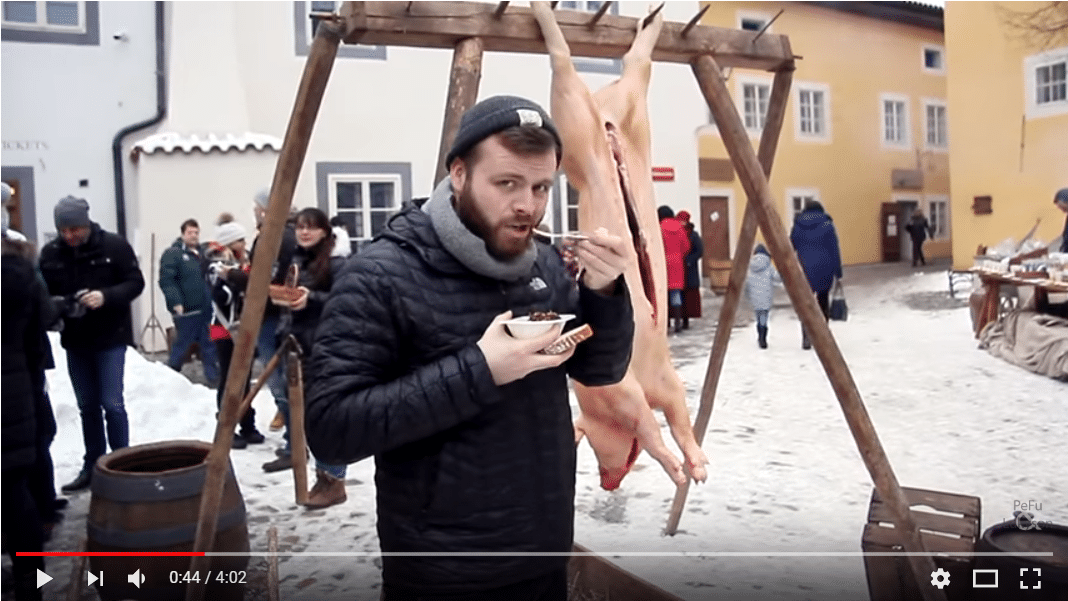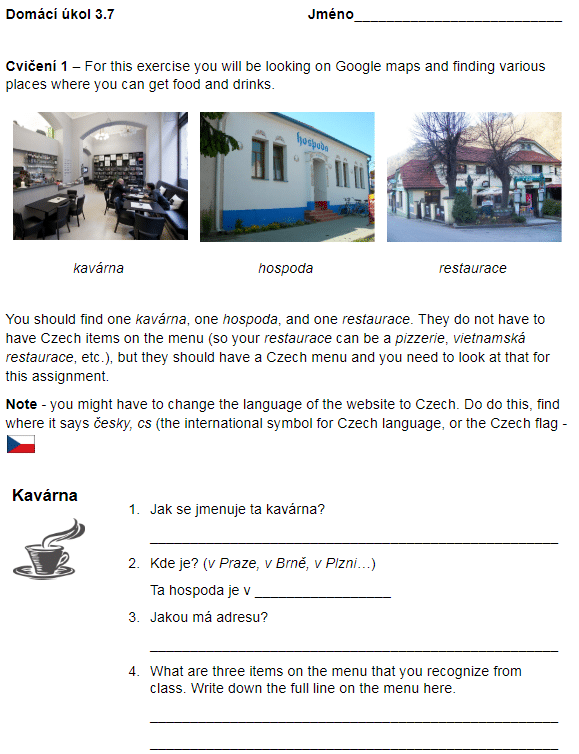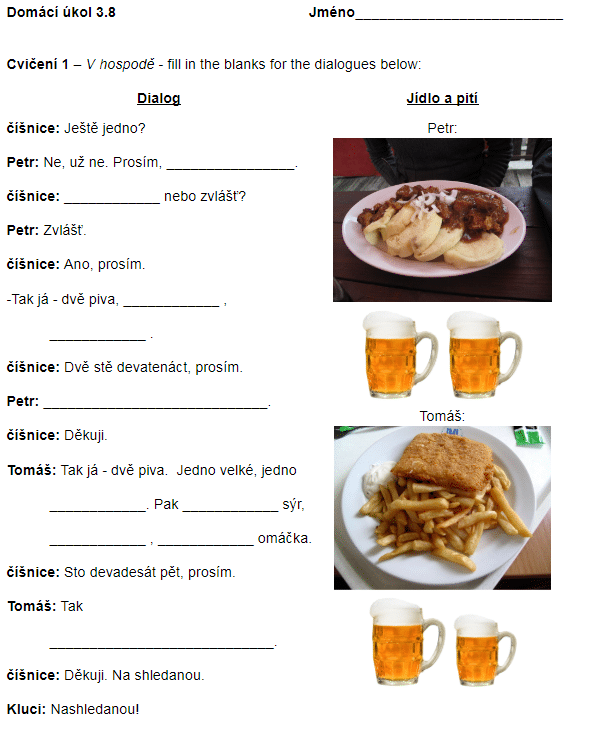|
|
Using the Reality Czech Curriculum |
The Reality Czech curriculum is composed of multiple components which exist over several platforms (Reality Czech website, Canvas course site, Quizlet) as well as various media types (online and print). This document serves to provide an overview of these different components and how they fit together. Here is an example of what students see for each day:
Each unit begins with a description of the unit’s content as well as communicative goals and the grammar and vocabulary students will need to achieve these goals. Here is an example of what students see at the beginning of a unit:
|
Unit 3 – Food and Drink – Jídlo a pití In this unit students are introduced to food vocabulary and talk about a variety of things related to food, including your food preferences, your cooking habits, and restaurants you like and this like. They learn about typical Czech meals and dishes served in restaurants and beverages served in pubs and cafes and how to order and pay for these items in Czech. |
||
|
Communicative Goals |
Grammar |
Vocabulary |
|
|
|
Unit Structure
The Reality Czech course utilizes techniques of blended learning and is designed from the ground up to leverage the advantages of online instruction in combination with classroom activities. In other words, Reality Czech is an example of a so-called flipped classroom. When learning and practice can be best achieved through independent work, these tasks are completed at home. On the other hand, students benefit greatly from interaction with each other and an instructor. These activities are specifically situated within classroom instruction.
Units are subdivided into between 10-12 modules that correspond to instructional days during the semester. Each day contains a pre-class, in-class, and post-class component which are completed sequentially:
Pre-class
New concepts are introduced and students are given opportunities to practice them. The following components are typically included in a pre-class for a given day:
Vocabulary Learning – Vocabulary is provided to students at the beginning of each unit in the form of a list, but much of the vocabulary is best learned in parts as it becomes contextually relevant for meeting communicative goals. Students are introduced to new vocabulary primarily through the Quizlet platform, which offers many different ways of learning vocabulary. The following types of activities are utilized multiple times throughout a unit to introduce, drill, and ultimately activate vocabulary:
|
flashcards – each card includes a picture with the Czech word next to it. Pairing vocabulary words with pictures strengthens the link between concept and vocabulary item. Students may click on this Czech word to hear an audio recording of the vocabulary item. English definitions are provided on the reverse side of the card.
|
learning exercise – this Quizlet type consists of two components. The first component offers students the Czech word(s) and asks them to match them with an English definition paired with a picture. After several iterations, students are then asked to write out the Czech words for given English word/picture. |
|
write in target word – here students are asked to write in the Czech equivalent of English words which are paired with a picture.
|
matching 1 – Here students match a Czech word to picture with English description. |
|
listen and write – students see a picture and hear the Czech word being pronounced. They are then asked to write that word in Czech. This exercise further reinforces the link between a Czech word and its meaning and crucially makes listening a key component of vocabulary/meaning integration. |
matching 2 – for this exercise students can only match Czech words with a picture. This exercise further aids in vocabulary/meaning integration. |
|
Interview Videos – Every unit has a list of questions that students should be able to answer by the end of the unit and correspond to the unit’s communicative goals.
These videos are compilations of speakers responding to these questions and each video contains 3-7 native speakers responding to a single question. These videos are completely unscripted and therefore occasionally words and forms are used that the students have not encountered. Frequently these videos provide an inductive way of learning new forms and vocabulary, as frequently grammar is used and then subsequently taught in grammar lessons. The interview videos are presented to the students on Canvas and are followed by quizzes which assess the students’ comprehension of the content, largely through multiple choice and true/false questions, as well as some free response. |
|
|
Cultural Lessons – Culture is frequently integrated into vocabulary lessons and grammar instruction in the sense that these topics often go hand in hand together. An effort is made to provide both low and high culture to students. An effort is made to provide both accurate information and also avoid providing a stereotyped description of Czech culture. To that end, non-canonical culture is also introduced through videos, especially openly licensed content found on the internet. |
Grammar Lessons and Exercises – Czech has a complex morphology and elaborate case system. This and other concepts such as verbal aspect, determinacy in motion verbs, etc. require a certain amount of overt grammatical instruction throughout the course. While there is a heavy grammar emphasis at times, students learn the grammar that is necessary to meet the communicative goals. While this is a departure from the heavier grammar-driven approach of most textbooks of Czech currently available, we have found that this approach results in better results and longer retention of grammar.
|
|
|
|
Grammar is introduced using clear terminology. An effort is made to avoid overly complex technical language. Additionally, grammar explanations are accompanied by frequent pictures to illustrate the concepts being learned. |
Learning quizzes are also a key component of the course. These quizzes provide immediate feedback and are scored for points. Students are given two attempts and the correct answers are given after the second attempt. |
|
SoundCzech – SoundCzech is a radio program on Czech Radio which explores the Czech language through songs. Typically they take one or two lines from a song and expand on them to include a variety of useful and interesting phrases. These are incorporated into relevant pre-class assignments approximately 2-3 times per unit. They are followed by a quiz to make sure that the students completed the listening and reading. A key useful phrase or two is then selected from this and becomes the locus of a class activity the following day. |
|
Thematic Videos – thematic videos contribute both to learning about Czech culture as well as language instruction. They are typically first introduced in class and are followed by a quiz which tests comprehension of content and language.
|
|
|
|
Here an example of a video shot for the course in the popular pub Lokál. It demonstrates ordering and eating in a pub in the Czech Republic. |
This is an example of a YouTube video under and open license (CC-BY) which is being used for the course. |
In-class
The classroom is understood as the primary place for interaction in Czech for students. Grammar and endings are not the primary focus of instruction at this time and thus there is nearly a complete absence of these types of exercises in class. Face-to-face classroom time is reserved specifically for activities that further the goal of interaction and language production.
The Reality Czech activity book is the primary source of materials for classroom activities. The goal of the activity book is to provide opportunities for speaking in pairs, groups, and between the class and the instructor in a structured manner. An effort is made to vary the types of activities so that a student has opportunities to interact with multiple people in a variety of ways throughout a class meeting.
The content of a day’s meeting flows directly from the materials students learned in the pre-class assignment completed prior to that day’s meeting. It draws on all of the components, such as the Interview Videos, grammar lessons, cultural lessons, and other components such as SoundCzech.
|
|
|
|
Sample pages from the Unit 3 activity book. |
|
Post-class
Following their class meeting, students complete a post-class assignment that builds upon material from the pre-class. While the pre-class stresses learning of forms and mastery of endings, the post-class frequently builds upon the students’ ability to create language in ways that were practiced during the in-class meeting. They also frequently involve looking at websites or other authentic materials and responding in directed ways about the materials they are looking at. These post-class assignments are printable from the Canvas site and turned in the following day in class.
|
|
|
|
Examples of Unit 3 post-class assignments. |
|




















